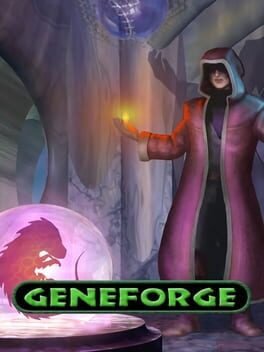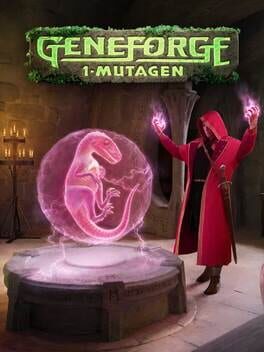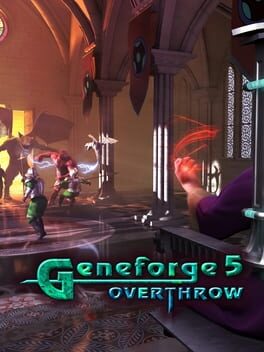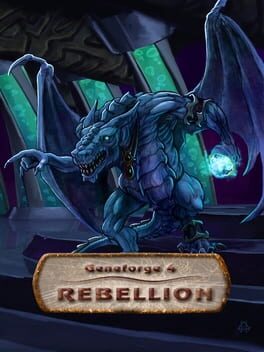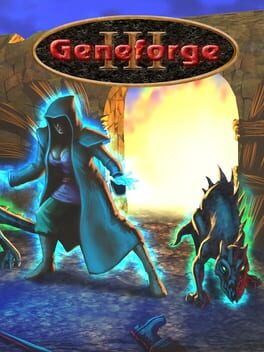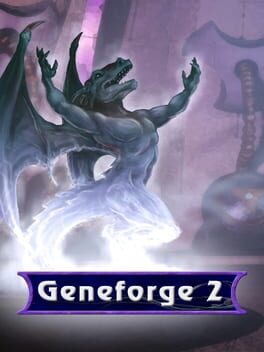

Geneforge is an Indie fantasy role-playing game, the first game in the five-part Geneforge Saga. It features an enormous world, the ability to create your own army of lethal, totally obedient creatures, and a cunning enemy AI with foes who can go on patrols, stalk you, and run for help. Geneforge has a huge and open storyline. You have the freedom to choose your own path and decide how the story will turn out. You can fight the evil overlord or you can join him. You can help the peasants or you can torment them. You can be the bold hero or you can just try to get away. No matter what you choose, Geneforge offers an enormous adventure with plenty of replay value.
Also in series
Released on
Genres
Reviews View More
This review contains spoilers
Most rpgs I have played tend to be maximalist in their structure and presentation, offering a sprawling 30+ hour experience stuffed with loot, quests and maybe some pretty vistas. Having a lot of 'stuff' for the player to mess around is an effective way to solve the problem of replicating a genre that has its origins in the infinite theatre of the mind. But it’s not the only way.
Geneforge has some things in common with that brief description above sans the pretty vistas. But these elements are informed by the fact that Geneforge was primarily coded and designed by one person, the self-described 'bottom feeder' Jeff Vogel who in his long career of annually released shareware has advocated strict economy in production and game design, something that's immediately apparent in how his games look.
It’s something of a running joke among Jeff and his base that his games have never looked or sounded particularly modern with their crude repetitive sprites, sparse repeated backgrounds and absence of an audio palette outside of store-bought sounds. Geneforge, possessing all of the above, wasn’t a looker in 2001 yet while its presentation is hardly immersive, it neither detracts from the experience too. Everything is rendered cleanly and legibly and the repeated ambient sounds emphasise the naturalism of the island setting.
That setting is the key to Geneforge's success and I want to return to what I said earlier about maximalism. Many rpgs try to spread their net as far as wide in terms of scope, offering entire countries, continents or even worlds. The effect of which sometimes only highlight the artificial nature of these worlds. Geneforge firstly does define its world where shapers (basically summoners) are the elite of their civilization due to their ability to shape life and create creatures for whatever purpose they deem fit. Secondly however, Geneforge, almost in the spirit of a microhistory, immediately limits the vast potential of this world to a forbidden island where you, a shaper in training, gets shipwrecked after being attacked by mysterious assailants. Ostensibly the arc of the game is trying to get off the island but this is really just an excuse for the actual journey of self-discovery. Sucia Island defined by a pervasive sense of mystery that feeds directly into a loop of exploration. Instead of creating a continuous game space, Vogel split the island into 80 or so small zones that form an interconnected grid not dissimilar to how Ivalice in FF12 is structured. Nearly every zone has multiple exits and there is rarely one route to a destination in mind. While these zones share the same assets and activities (looting and fighting), they nonetheless feel distinct from one another due to how fast travel works. Every zone has a hidden objective that once fulfilled marks that zone as cleared and free to fast travel to. However, 'cleared' zones need to be beside each other in order to take advantage of fast travel, for instance, you cannot fast travel to a cleared zone that is surrounded by uncleared zone thus encouraging you to create a safe route by fulfilling these objectives. Whilst some of these objectives are as simple as clearing all enemies in a zone, most pertain to something unique within that zone that reinforce the players engagement and understanding of the island. As such, although quite crude Geneforge's world design facilitates a meaningful dialogue between player and environment.
This mechanical relationship with Sucia Island is given further meaning by its narrative implications as a forbidden island. Once another shaper colony, the discoveries made upon the island were deemed sufficiently unsettling enough to recall all shapers to the mainland. In colonial retreat, a more subversive process occurred: the Servile creatures indifferently abandoned by their creators did not perish but lived and indeed thrive in their masters absence. Sucia island is fascinating as a setting then because instead of simply being an easily translatable facsimile of the Geneforge world it instead serves as a twisted mirror of it, a place where the abandoned experiments and industrial ruins shadow the Shapers claim to ascendancy. The Serviles themselves are the flesh and blood of this premise. In many ways, Geneforge is really about them and the world that they have been building for themselves in the absence of their creators. They comprise three sects: the Obeyers, who seek a return to the Shaper overlordship, the Takers who view all Shapers as oppressors to be taken down (my favourite of the bunch) and the Awakened who simply seek acceptance from the Shapers and co-existence on the basis of equality. It is a vibrant ever-changing society whose multifaceted divisions are the natural outgrowth of century long identity formation, a rarity in a genre that often reduces culture and identity to static atavism. And the complexity of this world creates opportunity for richer self-expression. Geneforge starts with the protagonist as an apprentice shaper and thus already comfortable in the shaper worldview. Even your most positive reaction to the first Serviles you meet is reluctant acceptance of their newfound autonomy. Yet as you engage more with this new world, that originally simplistic understanding gradually breaks down with every nuance. Take the Takers for instance. They are the most hostile to your presence and you can’t even enter their territory without being openly attacked. Yet when I persisted in travelling through their wasted lands and gaining an audience with their leader, I discovered a history of ecological collapse and collective trauma. The Takers’ ancestors had the misfortune of living near a dumping ground of toxic experiments that the departing Shapers created as they left, their parting gift effectively poisoning the air and the earth. These Serviles were fatally burdened with the debt of a few indifferent officials who in all likelihood enjoyed comfortable and healthy lives on the mainland. Thus, thus the Takers found their voice and from hearing their tale, my character too. Ruins that I previously considered mysterious and exciting escapades of an unknowably past become recontextualised as reminders of a world that very much still existed, and one that I would inevitably have to return to.
Find a way off the island. From the onset Geneforge constantly advertises its end. Many rpgs are keen on leaving their end goals either ambiguous or contingent to revision so to constantly string the player along their epic journeys. For all that you discover and experience in Geneforge, there is an implicit understanding that it will all have to be left behind. Just as the past of Sucia Island was a constant ever-changing thing, so too is its present. It is similar to Fallout New Vegas in that you are witness to a world that will soon utterly change and become unrecognisable. Even though it’s still a few dozen hours in length, my time in Geneforge felt fleeting and melancholy as I watched the ending slides. In spite of its primitive production values or maybe because of them, I still think about all that I experienced. Shorn of the epic conventions and cruft of other rpgs, I felt I was able to more clearly connect to everything laid out for me. There was so much more I wanted to talk about in this review, however given that it has already turned out to be as bloated and unfocused as Geneforge isn’t, I thought it best to restrict myself to my most coherent observations. Even as I currently play Geneforge 2, Sucia Island is never far from my mind. I will return to it one day.
Geneforge has some things in common with that brief description above sans the pretty vistas. But these elements are informed by the fact that Geneforge was primarily coded and designed by one person, the self-described 'bottom feeder' Jeff Vogel who in his long career of annually released shareware has advocated strict economy in production and game design, something that's immediately apparent in how his games look.
It’s something of a running joke among Jeff and his base that his games have never looked or sounded particularly modern with their crude repetitive sprites, sparse repeated backgrounds and absence of an audio palette outside of store-bought sounds. Geneforge, possessing all of the above, wasn’t a looker in 2001 yet while its presentation is hardly immersive, it neither detracts from the experience too. Everything is rendered cleanly and legibly and the repeated ambient sounds emphasise the naturalism of the island setting.
That setting is the key to Geneforge's success and I want to return to what I said earlier about maximalism. Many rpgs try to spread their net as far as wide in terms of scope, offering entire countries, continents or even worlds. The effect of which sometimes only highlight the artificial nature of these worlds. Geneforge firstly does define its world where shapers (basically summoners) are the elite of their civilization due to their ability to shape life and create creatures for whatever purpose they deem fit. Secondly however, Geneforge, almost in the spirit of a microhistory, immediately limits the vast potential of this world to a forbidden island where you, a shaper in training, gets shipwrecked after being attacked by mysterious assailants. Ostensibly the arc of the game is trying to get off the island but this is really just an excuse for the actual journey of self-discovery. Sucia Island defined by a pervasive sense of mystery that feeds directly into a loop of exploration. Instead of creating a continuous game space, Vogel split the island into 80 or so small zones that form an interconnected grid not dissimilar to how Ivalice in FF12 is structured. Nearly every zone has multiple exits and there is rarely one route to a destination in mind. While these zones share the same assets and activities (looting and fighting), they nonetheless feel distinct from one another due to how fast travel works. Every zone has a hidden objective that once fulfilled marks that zone as cleared and free to fast travel to. However, 'cleared' zones need to be beside each other in order to take advantage of fast travel, for instance, you cannot fast travel to a cleared zone that is surrounded by uncleared zone thus encouraging you to create a safe route by fulfilling these objectives. Whilst some of these objectives are as simple as clearing all enemies in a zone, most pertain to something unique within that zone that reinforce the players engagement and understanding of the island. As such, although quite crude Geneforge's world design facilitates a meaningful dialogue between player and environment.
This mechanical relationship with Sucia Island is given further meaning by its narrative implications as a forbidden island. Once another shaper colony, the discoveries made upon the island were deemed sufficiently unsettling enough to recall all shapers to the mainland. In colonial retreat, a more subversive process occurred: the Servile creatures indifferently abandoned by their creators did not perish but lived and indeed thrive in their masters absence. Sucia island is fascinating as a setting then because instead of simply being an easily translatable facsimile of the Geneforge world it instead serves as a twisted mirror of it, a place where the abandoned experiments and industrial ruins shadow the Shapers claim to ascendancy. The Serviles themselves are the flesh and blood of this premise. In many ways, Geneforge is really about them and the world that they have been building for themselves in the absence of their creators. They comprise three sects: the Obeyers, who seek a return to the Shaper overlordship, the Takers who view all Shapers as oppressors to be taken down (my favourite of the bunch) and the Awakened who simply seek acceptance from the Shapers and co-existence on the basis of equality. It is a vibrant ever-changing society whose multifaceted divisions are the natural outgrowth of century long identity formation, a rarity in a genre that often reduces culture and identity to static atavism. And the complexity of this world creates opportunity for richer self-expression. Geneforge starts with the protagonist as an apprentice shaper and thus already comfortable in the shaper worldview. Even your most positive reaction to the first Serviles you meet is reluctant acceptance of their newfound autonomy. Yet as you engage more with this new world, that originally simplistic understanding gradually breaks down with every nuance. Take the Takers for instance. They are the most hostile to your presence and you can’t even enter their territory without being openly attacked. Yet when I persisted in travelling through their wasted lands and gaining an audience with their leader, I discovered a history of ecological collapse and collective trauma. The Takers’ ancestors had the misfortune of living near a dumping ground of toxic experiments that the departing Shapers created as they left, their parting gift effectively poisoning the air and the earth. These Serviles were fatally burdened with the debt of a few indifferent officials who in all likelihood enjoyed comfortable and healthy lives on the mainland. Thus, thus the Takers found their voice and from hearing their tale, my character too. Ruins that I previously considered mysterious and exciting escapades of an unknowably past become recontextualised as reminders of a world that very much still existed, and one that I would inevitably have to return to.
Find a way off the island. From the onset Geneforge constantly advertises its end. Many rpgs are keen on leaving their end goals either ambiguous or contingent to revision so to constantly string the player along their epic journeys. For all that you discover and experience in Geneforge, there is an implicit understanding that it will all have to be left behind. Just as the past of Sucia Island was a constant ever-changing thing, so too is its present. It is similar to Fallout New Vegas in that you are witness to a world that will soon utterly change and become unrecognisable. Even though it’s still a few dozen hours in length, my time in Geneforge felt fleeting and melancholy as I watched the ending slides. In spite of its primitive production values or maybe because of them, I still think about all that I experienced. Shorn of the epic conventions and cruft of other rpgs, I felt I was able to more clearly connect to everything laid out for me. There was so much more I wanted to talk about in this review, however given that it has already turned out to be as bloated and unfocused as Geneforge isn’t, I thought it best to restrict myself to my most coherent observations. Even as I currently play Geneforge 2, Sucia Island is never far from my mind. I will return to it one day.
